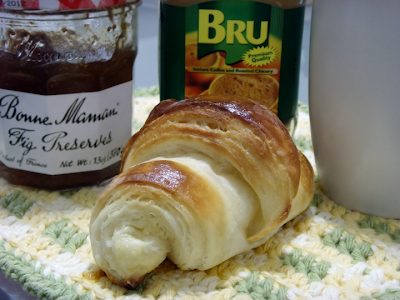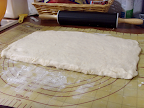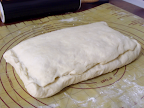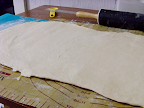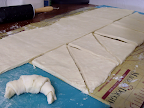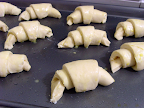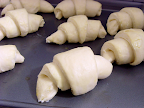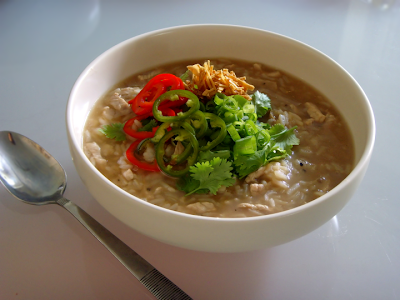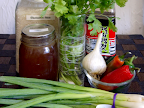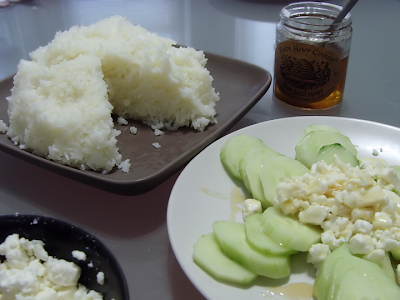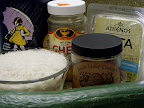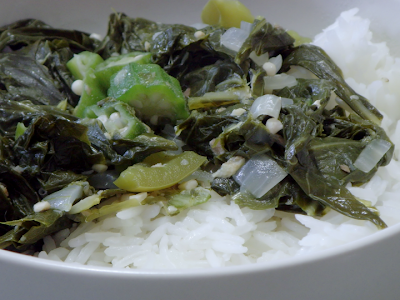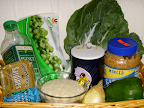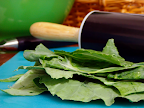Background
Clearly France is a country whose culinary credentials require no introduction. This reputation left us quite surprised when we realized that breakfast was simply bread, jam, and maybe a soft-boiled egg. The two best known bread products of France are the baguette and the croissant. The home recipes we found for the baguette were pretty simple, but as baguette is not really the same without a real baker's oven, we decided to attempt the croissants. A French friend recommended the Bonne Maman preserves, which are available in supermarkets. Our breakfast guest Stacy brought the French-influenced chicory coffee.
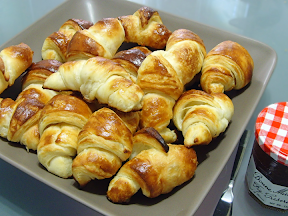 For our recipe source we chose Paris Boulangeries-Patisserie by Linda Dannenberg. This book gives the recipes from her favorite bakers all across Paris. The croissant recipe comes from Marcel Haupis, whose shop is on Ile-St-Louis in the middle of the Seine River. My first impression of the recipe was that is was very scary. In total it involves 6+ hours of rising and an intimidating amount of butter. We recommend starting the night before, so you don't have to get up at 3 AM.
For our recipe source we chose Paris Boulangeries-Patisserie by Linda Dannenberg. This book gives the recipes from her favorite bakers all across Paris. The croissant recipe comes from Marcel Haupis, whose shop is on Ile-St-Louis in the middle of the Seine River. My first impression of the recipe was that is was very scary. In total it involves 6+ hours of rising and an intimidating amount of butter. We recommend starting the night before, so you don't have to get up at 3 AM.Croissants
- 2 tbsp + 1 tsp of yeast
- 1/3 cup warm water
- 3 1/2 cups flour + 1/2 cup corn starch (or 4 cups cake flour, which we didn't have)
- 1/4 cup sugar
- 1 tbsp salt
- 1 cup milk
- 2 sticks of butter (barely malleable)
- 1 egg, beaten
Note: This process is long and involved. Read through the entire recipes and make sure you plan ahead. We have included many photos of the process to better illustrate the process.
Combine yeast and warm water. Let it sit for 5 minutes while the yeast activates.
Mix all the remaining ingredients except the egg with a wooden spoon.
Then mix using an electric mixer and a dough hook until you can form it into a ball. Err on the side of under-working the dough.
Knead the dough on a lightly floured surface until the dough is smooth but still soft.
Work the dough into a ball.
Place the dough in a greased bowl and let it rise for 1 hour. Then refrigerate the dough for 30 minutes.
Roll out the dough until it is 9 x 15 inches and 3/8 inch thick and let rest for 5 minutes.
As the dough is rising take two sticks of butter out to soften.
Put the butter on a piece of wax paper.
The butter should malleable but not too soft.
Work the butter in a square that is 5 x 7 inches and 1/2 inch thick.
Place the butter on the bottom third of the dough.
Fold the top third of dough over the middle third and then fold this over the bottom third like a business letter.
Seal the edges of the dough.
Roll out the dough lengthwise until it is 9x16 inches.
Repeat the folding process and refrigerate the dough for 10 minutes. This completes the second fold.
Repeat this process for a third fold, refrigerate again for 10 minutes.
After a fourth fold, seal the edges dust the surface with flour.
Wrap in plastic and refrigerate over night.
(This folding process creates layers of butter that help to create the pockets and flakes in the croissant. See if you can calculate how many layers of butter this will create.)
The next morning unwrap the dough and let it rest for a few minutes at room temperature.
Roll the dough into a rectangle 12 x 30 inches.
Cut the dough down the middle using a chef's knife.
Square off the edges of the two strips and cut the strips into 5 x 6 inch rectangles.
Then cut along the diagonal starting in the bottom corner and moving up.
Starting at the 5 inch side of the triangle, roll the dough into the appropriate shape with the tip of triangle coming into the middle.
Shape it into a crescent and place onto a dampened cookie sheet. Make sure the tip is under the croissant to keep it from unfolding during baking.
Brush with the egg and let rise for 2 more hours.
20 minutes before you put the croissants in the oven pre-heat it to 400 F.Results
Put on a final brush of eggs and place in the oven for 10 minutes.
Monitor them as they cook and take them out if they start to burn.
These turned out really well. Really, really well. They smelled great as they cooked and the smell lingered for a long time. They were warm, soft, flaky, and tasted great with the fig preserves. They oozed butter as they cooked so we highly recommend a baking tray with edges.
It felt really awesome that these work. After completing this meal I want to try to bake more things. The book we got this recipes from has lots of other challenges that look great and I want to try.
We should also say that this recipe produces lots croissants. You should bring the leftovers to work to show how much cooler you are because you made croissants from scratch.
The answer is 27.
